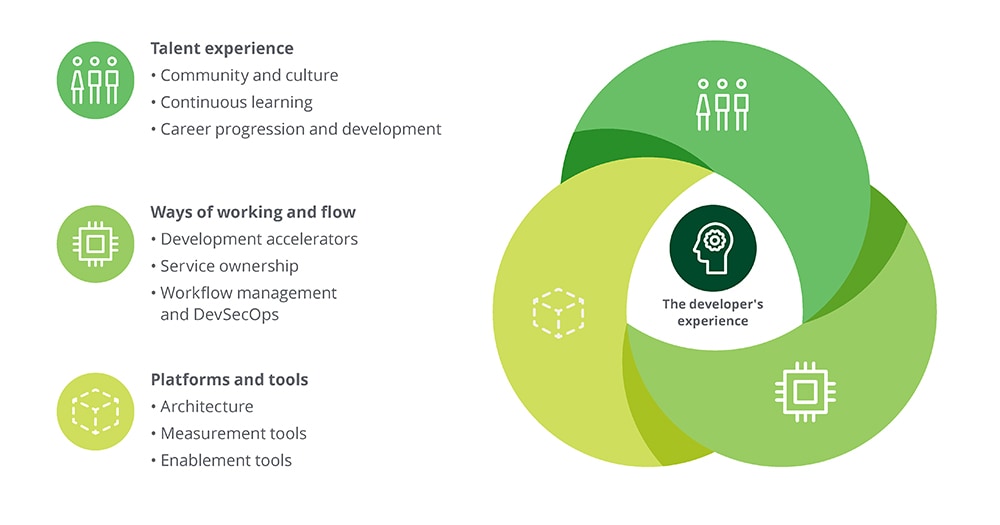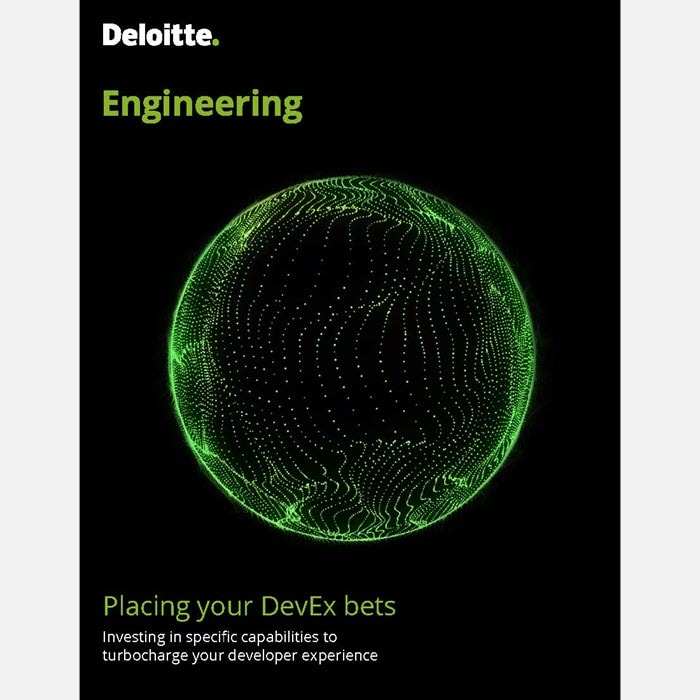Placing your bets: Developer experience strategy has been saved

Perspectives
Placing your bets: Developer experience strategy
How to invest in the experience of your developer teams
A good strategy for developer experience leads to innovation. But it also takes many interlocking capabilities. To jump-start the developer experience journey for your teams, where should you start? Learn about a three-part capabilities framework based on the experiences of leading developer organizations that have blazed a trail for engineering excellence.
Why developer experience strategy is more critical than ever
In today’s rapidly changing technological landscape, developers play a crucial role in driving innovation and growth while building the technology that powers the business. Companies that invested more heavily in engineering teams and infrastructure reported better outcomes. Specifically, companies that spent more than 10% of their engineering time on developer productivity had 2.3 times higher revenue growth rates than companies that spent less than 10% of their engineering time on developer productivity.1 Organizations that attract and retain top engineering talent were more likely to outperform their peers in terms of revenue growth, market share, and profitability.2
Accelerating developer experience (DevEx) has become more pivotal than ever, but many companies are still working on a concrete strategy to start or focus their investments. In this article, we explore a framework of mutually reinforcing capabilities that an organization can use as a “gameboard” in thinking through their DevEx investments.
Standardizing capabilities to turbocharge the experience of developer teams
In our last article, “Defining a North Star for your developer experience,” we introduced a set of developer archetypes that characterize an organization’s developer experience strategy. Each developer archetype has a distinct vision and execution strategy, and—as a result—requires a unique mix of capabilities across talent, technology, and ways of working. In this article, we dive deeper into the specific set of capabilities organizations may choose to focus on in each archetype. First introduced in our Tech Trends 2024 series, our DevEx Capabilities framework represents a set of mutually reinforcing capabilities that companies can weave together to accelerate developer impact.3

The 3-part framework for developer experience capabilities
All archetypes rely on categories of capabilities: platforms and tools, culture and talent, and ways of working; however, they prioritize and sequence specific capabilities in different ways, depending on their strategic objectives.4
This category of capabilities includes strategic architectural decisions, sophisticated tooling, and robust frameworks—establishing the critical technology underpinnings to support relentless improvement. A well-designed architectural foundation lays the groundwork for streamlined workflows while minimizing technical debt and enabling developers to focus on innovation. Cutting-edge tools, meticulously curated based on industry best practices, contribute significantly to efficiency gains—automating repetitive tasks and helping developer teams experience flow.
- Architecture underpins the developer tooling ecosystem. A well-designed structure reduces complexity by simplifying development tasks, enhancing code readability, and minimizing technical debt—all in service toward system performance improvements.
- Measurement tools via telemetry capture and analyze various metrics and performance indicators throughout the development life cycle. These tools help developers identify bottlenecks, track progress, and ensure adherence to coding standards, providing the critical transparency that engineering teams need to experience continuous improvement.
- Enablement tools include a variety of applications and resources that support developers in their coding tasks, such as integrated development environments (IDEs), documentation, training materials, and collaboration platforms. Enablement tools play a crucial role in enhancing developer experience and productivity through contextual learning, which helps teams reduce task-switching to stay in flow and minimize onboarding time.
This set of capabilities focuses on the day-to-day experience for developer and support teams, allowing them to prioritize the most important work and get through their tasks efficiently by achieving consistent and predictable flow. The surge in AI-assisted coding tools (what we would classify as “development accelerators”) has catapulted this category of capabilities into the spotlight. “Ways of working” includes the following capabilities:
- Service ownership simplifies and streamlines responsibility for the entire life cycle of a service—from development through ongoing maintenance—to reduce dependencies, improve quality, and enhance reliability. Clear service ownership results in greater performance of the developer tooling ecosystem.
- Workflow management provides tools to help developers prioritize the most important tasks, while establishing processes that automate manual handoffs, reduce ambiguity, and enhance cross-functional collaboration. The result is greater developer harmony and product quality.
- Development accelerators speed up the software development process by reducing repetitive tasks, minimizing manual errors, and providing consistent development patterns. The result is greater efficiency across the software development life cycle (SDLC).
This set of capabilities focuses on building better teams through learning and development, career progression, and culture. Often overlooked, these “talent experience” capabilities are a critical part of the strategy to cultivate a developer-centric mindset that drives true developer productivity. More recently, questions around the ethical implications of AI and a greater emphasis on equity and inclusion in software development only make investments in these capabilities that much more important. Commitment to these capabilities will not only elevate developer satisfaction and productivity but also reduce churn—affecting both the top and bottom line.
- Community and culture are the manifestation of shared values and a common language, bringing a sense of purpose and belonging to team members, resulting in greater collaboration and teaming.
- Continuous learning supports developers through the ongoing acquisition of new skills, knowledge, and capabilities (both soft and technical). This can include formal education and training programs as well as informal, self-directed learning. Designing programs with the long-term success of developers in mind (beyond the scope of just their current role), elevates the proficiency of the entire developer workforce.
- Career progression and mobility creates opportunities for advancement, skill diversification, and role exploration. Developers are more likely to stay with an organization that invests in their professional growth and provides clear pathways for advancement. Investments in this category contribute to developer satisfaction and reduce churn.

Learn how to manage time and investments according to your DevEx archetype.
Get in touch with our team
Get in touch

Principal
Developer Experience
Strategy and Roadmap
Deloitte Consulting LLP

Senior Manager
Developer Experience
and
Platform Engineering
Deloitte Consulting LLP

Managing Director
Developer Experience
Strategy
Deloitte Consulting LLP

Senior Manager
Developer Experience
Strategy
Deloitte Consulting LLP

Principal
Developer Experience
Strategy
Deloitte Consulting LLP
Endnotes
1Stripe, “The developer coefficient,” September 2018.
2Rob Goffee and Gareth Jones, “Creating the best workplace on Earth,” Harvard Business Review, May 2013.
3Mike Bechtel and Bill Briggs (eds.), Tech Trends 2024, Deloitte Insights, 2024.
4Ibid.
Recommendations
Defining a North Star for your developer experience
Accelerate developer innovation and productivity
Accelerating developer experience (DevEx)
Designing for developers in a digitally fueled economy



